电气工程专业英语翻译
- 格式:docx
- 大小:375.17 KB
- 文档页数:8
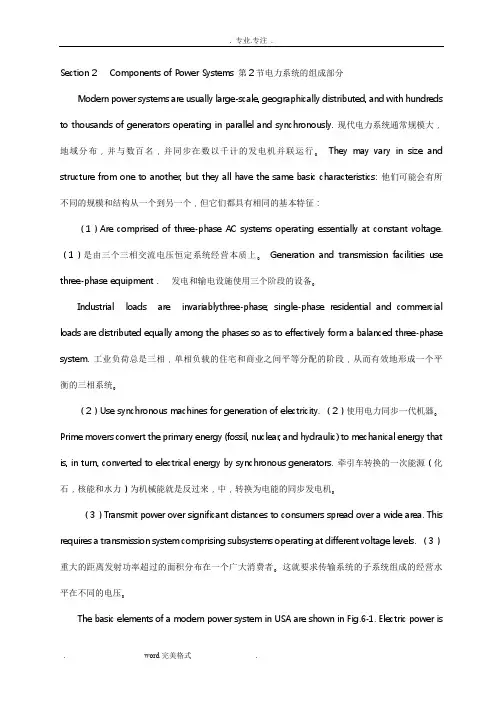
Section 2 Components of Power Systems 第2节电力系统的组成部分Modern power systems are usually large-scale, geographically distributed, and with hundreds to thousands of generators operating in parallel and synchronously. 现代电力系统通常规模大,地域分布,并与数百名,并同步在数以千计的发电机并联运行。
They may vary in size and structure from one to another, but they all have the same basic characteristics: 他们可能会有所不同的规模和结构从一个到另一个,但它们都具有相同的基本特征:(1)Are comprised of three-phase AC systems operating essentially at constant voltage. (1)是由三个三相交流电压恒定系统经营本质上。
Generation and transmission facilities use three-phase equipment . 发电和输电设施使用三个阶段的设备。
Industrial loads are invariablythree-phase; single-phase residential and commercial loads are distributed equally among the phases so as to effectively form a balanced three-phase system. 工业负荷总是三相,单相负载的住宅和商业之间平等分配的阶段,从而有效地形成一个平衡的三相系统。
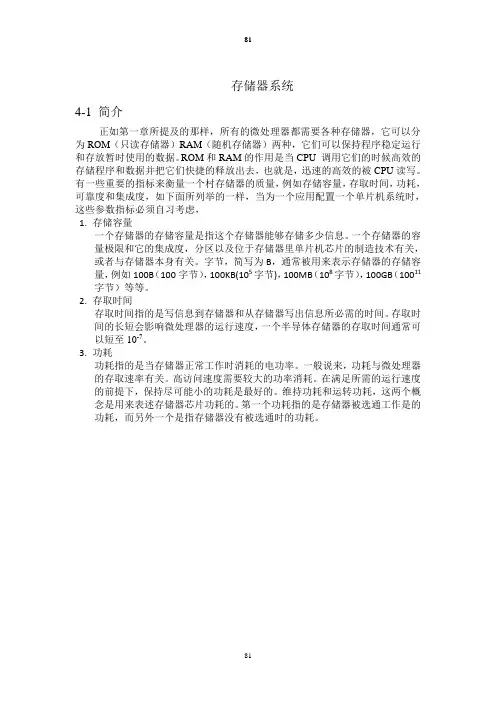
存储器系统4-1 简介正如第一章所提及的那样,所有的微处理器都需要各种存储器,它可以分为ROM(只读存储器)RAM(随机存储器)两种,它们可以保持程序稳定运行和存放暂时使用的数据。
ROM和RAM的作用是当CPU 调用它们的时候高效的存储程序和数据并把它们快捷的释放出去,也就是,迅速的高效的被CPU读写。
有一些重要的指标来衡量一个村存储器的质量,例如存储容量,存取时间,功耗,可靠度和集成度,如下面所列举的一样,当为一个应用配置一个单片机系统时,这些参数指标必须自习考虑,1.存储容量一个存储器的存储容量是指这个存储器能够存储多少信息。
一个存储器的容量极限和它的集成度,分区以及位于存储器里单片机芯片的制造技术有关,或者与存储器本身有关。
字节,简写为B,通常被用来表示存储器的存储容量,例如100B(100字节),100KB(105字节),100MB(108字节),100GB(10011字节)等等。
2.存取时间存取时间指的是写信息到存储器和从存储器写出信息所必需的时间。
存取时间的长短会影响微处理器的运行速度,一个半导体存储器的存取时间通常可以短至10-7。
3.功耗功耗指的是当存储器正常工作时消耗的电功率。
一般说来,功耗与微处理器的存取速率有关。
高访问速度需要较大的功率消耗。
在满足所需的运行速度的前提下,保持尽可能小的功耗是最好的。
维持功耗和运转功耗,这两个概念是用来表述存储器芯片功耗的。
第一个功耗指的是存储器被选通工作是的功耗,而另外一个是指存储器没有被选通时的功耗。
4.可靠性存储器的可靠性指的是存储器抵抗环境条件干扰的能力,例如电磁场,温度,湿度等等其它的因素。
这就是说由VLSI技术生产的存储器具有很高的可靠性。
5.集成度集成度指的是多少个同等的半导体管或基本存储电路可以杯集成到一块芯片上。
每个基本存储电路可以存储一位二进制信息,因此,这句话可被表述为“位/片”。
例如,27656型存储器的集成度是256KB/片。
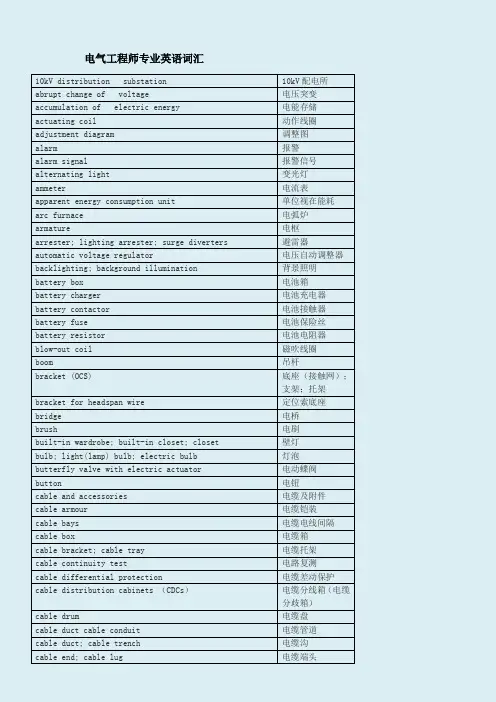
电气工程师专业英语词汇10kV distribution substation 10kV配电所abrupt change of voltage 电压突变accumulation of electric energy 电能存储actuating coil 动作线圈adjustment diagram 调整图alarm 报警alarm signal 报警信号alternating light 变光灯ammeter 电流表apparent energy consumption unit 单位视在能耗arc furnace 电弧炉armature 电枢arrester; lighting arrester; surge diverters 避雷器automatic voltage regulator 电压自动调整器backlighting; background illumination 背景照明battery box 电池箱battery charger 电池充电器battery contactor 电池接触器battery fuse 电池保险丝battery resistor 电池电阻器blow-out coil 磁吹线圈boom 吊杆bracket (OCS) 底座(接触网);支架;托架bracket for headspan wire 定位索底座bridge 电桥brush 电刷built-in wardrobe; built-in closet; closet 壁灯bulb; light(lamp) bulb; electric bulb 灯泡butterfly valve with electric actuator 电动蝶阀button 电钮cable and accessories 电缆及附件cable armour 电缆铠装cable bays 电缆电线间隔cable box 电缆箱cable bracket; cable tray 电缆托架cable continuity test 电路复测cable differential protection 电缆差动保护cable distribution cabinets (CDCs)电缆分线箱(电缆分歧箱)cable drum 电缆盘cable duct cable conduit 电缆管道cable duct; cable trench 电缆沟cable end; cable lug 电缆端头cable fault locator 电缆故障探测仪cable gallery 电缆廊道cable hanger; cable suspender 电缆吊架cable laying laying of cables 电缆敷设cable marking 电缆标志cable rack 电缆架cable shaft 电缆竖井cable sleeve; electrical wire conduit 电缆套管cable support 电缆支架cable tapping box 电缆分接箱cable terminal 电缆终端cable terminal box 电缆盒cable tray 电缆托架cable trenches with chequer plates 带方形盖板的电缆沟槽cable trough 电缆沟槽cable trough; trough 电缆槽cable tunnel; cable-subway 电缆隧道cable vault 电缆室cable work 电缆厂capacitance 电容capacitance compensation 电容补偿capacitive charges 电容电荷capacitive voltage transformer 电容式电压互感器capacitor 电容器capacitor bank 电容器组capacitor compensator 电容补偿器capacitor coupling 电容耦合capacitor filtering 电容滤波catenary/messenger 承力索catenary; messenger wire; catenary wire 承力索ceiling lamp ceiling light 顶灯ceramic wall bushings 穿墙套管changeover box 电源切换箱changeover box for smoke curtain 挡烟垂幕电源切换箱circuit 电路circuit connection 电路接线circuit diagram 电路图circuit diagrams 电路图circuit diagrams 电路图circuit parameter 电路参数circuit-breaker unit 断路器单元closed circuit 闭路closed circuit TV (CCTV) 闭路电视cod for electrical design and installation 电气设计安装规coefficient of resistivity 电阻系数compensation 补偿compensation reactor 补偿电抗器concealed piping; concealed pipe 暗管concealed wiring; concealed electric wiring 暗线condenser 电容器condenser bank(block) 电容器组condenser charge 电容器充电condenser discharge 电容器放电condenser reactance 电容器电抗conductor 导线conductor rail 导电轨conductor resistance 导体电阻contact 触头continuous carrying capacity 持续载流能力corona 电晕cross-span drop bracket 定位索定位支座current & voltage transducer 电流电压变换器current amplification 电流放大current relay 电流继电器current relay 电流继电器current transformer (CT) 电流互感器de-energize 断电diesel generator; diesel dynamo 柴油发电机diesel power plant; diesel generating station 柴油发电站differential protection 差动保护differential protection cables 差动保护电缆differential relay 差动继电器digital format 电子文档direct feeding system with return cable 带回流线的直接供电方式(TRNF供电方式)directional coil 定向线圈directional coupler 定向耦合器directional lighting 定向照明调度中心dispatching centre; load dispatching centre; controlcentredisplay lighting 陈列品照明district transformer station and distribution center 地区变、配电所drawer 抽屉柜drawout design 抽出式设计drop bracket 吊架drop bracket 定位单环, 定位支座dummy load; equivalent load 等效负载duration of short-circuit 短路电流 (持续)dust 尘埃dynamic analysis method 动态法dynamic inductance 动态电感elastic support structure 弹性支座结构ELE (elevator) 电梯electric bell 电铃electric coupler 电器连接electric displacement 电位移electric equipment inspection railcar 电气检测车electric hoist (block) 电动葫芦electric horn 电喇叭electric installation drawing 电气图纸electric joint 电气分断点electric potential 电势electric power fitting 电力金具electric railway 电气铁道electric resistance; resistivity 电阻率electric siren 电笛electric system 电气系统electric traction 电力牵引electric traction feeding system 电力牵引供电系统electric traction telemechanical system 电力牵引远动系统electrical apparatus for explosive atmospheres 爆炸环境用电气设备electrical design 电气设计electrical diagrams 电气图electrical energy 电能electrical equipment (appliance) 电器electrical experimental equipment 电工实验设备electrical installation; electrical fitting 电气安装electrical lamp; electric light 电灯electrical maintenance case 电器维修箱electrical outlet 电气出线口electrical rating 电气额定值electrician 电工electrification 电气化electrification interference 电气化干扰electrification interference 电气化干扰electrified railway 电气化铁路electrified railway remodeling 电气化铁道改造,电气化铁路改造electrified track 电气化铁道electromaginetic induction 电磁感应electromagnetic relay 电磁继电器electronic AC stabilizer 电子交流稳压器electronic information processing 电子信息处理electroplated coating of zinc 电镀锌emergency battery 备用电池energy transmission 电能传输exit light 安全出口灯factory site; location of factory 场致发光灯fall of current 电流下降fall of voltage 电压下降fastening blacket 抱箍fiber glass steel 玻璃钢floor special purpose receptacle 地面专用插座fluorescent lamp ballast with emergency function 带应急功能的荧光灯镇流器fly light gallery 灯光天桥frequency-modulated, digital telegram 调频数字电报galvanized iron wire strands 镀锌钢绞线galvanized steel sheet 镀锌钢管galvanometer; rheometer; current meter 电流计glass reinforced plastic 玻璃纤维加劲塑料ice 冰雪impulse current 冲击电流incandescent lamp base 白炽灯灯头incandescent lamp; incandescent filament lamp 白炽灯incandescent lighting 白炽灯照明inductance 电感inductance-capacitance meter 电感器industrial frequency AC electric traction system 单相工频交流电力牵引制inner covering 电缆内护层inner covering; bedding sheath 电缆内套insulation window 保温窗intensity of current 电流强度interrupter; circuit breaker; breaker 断路器,续断器interruption of current 断路isolux curve 等照度曲线kilowatt-hour meter; watt-hour meter; electric meter 电能表lamination 叠片lamp bridge 灯桥lamp socket; lamp holder; lamp base 灯座lamp; light; lantern 灯lamplight; lighting 灯光lamps; lighting fixtures 灯具lampshade lamp cover 灯罩leading 超前lead-out 出线life terminal 带电端子light control 灯光控制light trough; light slot; troffer 灯槽lighthouse beacon; pharos 灯塔lighting standard; lighting post; lighting pole 灯柱lightning protection 避雷(防雷)lightning rod,lightning conductor 避雷针little poisonous 低毒little poisonous 低毒live 带电live 带电live equipment 带电设备live working 带电作业local power supply 地方电源low frequency 低频low smoke zero halogen cable 低烟无卤电缆low -voltage cable 低压电缆low voltage circuit 低压电路low -voltage control 低压控制low -voltage power distribution box 低压配电箱low -voltage protection 低压保护low -voltage switch 低压开关low -voltage switch cabinet 低压开关柜low-term overvoltage 短时过电压low-voltage switchgear 低压成套开关magnetic switch 磁力开关magnitude of voltage 电压值mains side 电流侧mains switch 电源开关mains transformer 电源变压器mains voltage 电源电压making capacity 闭合容量marker lamp 标志灯mild steel conduct rail; mild steel third rail 低碳钢接触轨modulator-demodulator (modem) 调制解调器motor-generator set 电动发电机组moving contact 动触头network command centre (NCC) 电网指挥中心nominal value 标称值nominal voltage 标称电压notch-off 断电ohmic loss 电阻损失one-way circuit 单相电路one-way feeding 单边供电open circuit breaker; cutout; circuit breaker (CB) 断路器open-circuit arc 断路电弧open-delta connection V形接法open-phase protection 断相保护装置operating system (OS) 操作系统operation of network 电网运行管理operation passageway 操作走廊outlet 出线口outlet 出线口outlet box 出线盒outlet box 出线盒overhead illumination; overhead lighting; top lighting 顶部照明panel; board 电屏parallel circuit; shunt circuit 并联电路parallel connection; shunt connection 并联parallel resistance 并联电阻patch board; patch 插头板PE (protective earth) 保护地pendant continuous row fluorescent fixture 吊装荧光灯带pendent(pendant) lamp ; drop light 吊灯permanent lighting 常设照明phasing device 定相器point to point configuration 点对点配置point welding machine 点焊机port 端口potential 电位potential difference 电位差potential fall; voltage drop 电压降potential rise 电压升potential transformer; inductive voltage transformer 电压互感器电压互感器potential transformer; pressure transformer; voltagetransformerpower administration 电业管理局power cable 电力电缆power cable well 电力电缆井power car 动力车辆power control box 动力控制箱power dispatch 电力调度power dispatcher 电调power lighting transformer feeder cubicle 动力变压器馈电柜power line harmonic current interference 电力线谐波干扰power source 电源power source bay 电源间隔power source for indication lamp 表示灯电源power supply cabinet 动力柜power supply cable 电力供电电缆power supply cable 电源线power supply of electric traction system 电力牵引供电系统电源power supply panel 电源屏power supply plug 电源插头power supply room 电源室power transformer substation; substation (SS) 动力变电所power transformers energy saving operation 电力变压器经济运行power transmission 电能输送power-line carrier channel; PLC-channel 电力线载波通道principle of superposition 叠加原理private wire 测试线protection panel 保护屏protective cable 保护电缆protective circuit 保护电路protective equipment of secondary circuit of power system 电力系统二次回路控制装置protective wire 保护线push button switch; push button; button switch 按钮开关push-button 按钮push-button control; button control 按钮控制reactance 电抗reactive current 电抗性电流reactive drop 电抗性电压降Reactors 电抗器reference electrode 参考电极registration device 定位装置registration wire 定位索resistance 电阻resistance value 电阻值resistivity 电阻率rheostatic control 变阻调速safety lighting 安全照明safety voltage 安全电压SCA (supervisory control and data acquisition) 电力监控系统sectioning 电分段sectioning 电分段sectioning point 电分段装置semi-autotensioned catenary equipment 半补偿链形悬挂semidirect lighting 半直接照明series battery 串联电池组series circuit 串联电路series connection 串联series-parallel circuit 串并联short circuit 短路short circuit calculation 短路计算short circuit detection transformer 短路监视互感器short-circuit current 短路电流short-circuit current 短路电流short-circuit current capacity 短路载流量short-circuit current setting calculation 短路电流整定计算short-circuit failure 短路故障short-circuit impedance 短路阻抗short-circuit loss 短路损耗short-circuit protection 短路保护装置short-circuiter 短路器short-time load 短时负载show-window lighting 橱窗照明shunt capacitors 并联电容sign illumination system 标志照明系统simple (catenary) equipment system with single contact wire 单接触线的简单链形悬挂single arm pantograph 单臂受电弓single core cable PVC jacket 单芯电缆PVC套single power supply 单电源single-phase motor 单相电动机single-phase system 单相系统single-phase two-wire system 单相两线制single-throw switch 单投开关slide-in (unit) 抽屉式socket; outlet; receptacle 插座spare fuses 备用保险丝spotlight; spot lamp 点光源stainless steel running face 不锈钢化性接触面standard light source 标准光源stand-by generator; reserved generator 备用发电机stand-by lighting 备用照明stand-by power source 备用电源star-delta connection Y-△接线start pulse 触发脉冲stitched catenary suspensic 弹性链形悬挂stitched catenary suspension 弹性链形悬挂stitched tramway type equipment 弹性简单悬挂strong current test panel (including rectifying and voltage regulating) 大电流测试 (含整流; 高压) 电源屏sub-distribution box 动力配电箱sub-distribution box for elevator 电梯配电箱superimposed load 超载superimposed load 叠加荷载supper-low voltage circuit 超低压电路surge arrester 电涌放电器switching-surge 操作过电压tagging 标签telephone interference 电话干扰tensioning equipment/tensioning device/tensioner 补偿器terminal 端子terminal block 端子板terminal block 端子排terminal box 端子箱terminal box 端子箱terminal insulator 端子绝缘terminal linkage board 端子连接板terminal of the cable linking box 电缆连接箱端子terminal point gun 端子连接器terminals for power supply 电源端子The trigger contains materials and equipment that are considered to be controlled commodities that either cannot be exported or that require an expert license. The list is an up-to date database maintained by Oak Ride National Laboratory (ORNZ) and has interactive search capacities. The list contains brief subject identifiers; you can “click” on a particular item to acquire detailed specifications. 出口材料和商品受控单time switch 定时开关traction transformer for single-phase V,V.connection 单相V,V.结线牵引变压器traction transformer of single-phase connection 单相结线牵引变压器transformer 动力变压器transformer bank 变压器组transformer box 变压器箱transformer capacity 变压器容量transformer coupling 变压器耦合transformer pole 变压器杆transformer protection panel 变压器保护屏transformer station; substation 变电所transmitting relay 传输继电器twin bracket 定位双环underground cable terminal box 地中电缆盒underground cable; ground cable 地下电缆uninterrupted power supply (UPS) 不间断电源(UPS) valve amplifier 电子管放大器vital aspect 安全显示voltage amplification 电压放大voltage below level 电压过低voltage distortion 电压畸变率voltage drop 电压损失voltage limiter 电压限制器(限压器)voltage regulator 调压器voltage unbalance 电压不平衡度voltmeter 电压表wall lamp; bracket light 壁灯washer 垫圈watt-hour meter; kilowatt-hour meter; electric meter 电表workshop power supply 车间电源workshop power supply 车间供电zinc-clad steel strand wire 镀锌钢绞线1. Personnel 人员职员2. V oltmeter 电压表伏特计3. Ohmmeter 欧姆计电阻表4. Megohmmeter 兆欧表5. Wattmeter 瓦特计电表功率6. Watt-hour 瓦时瓦特小时7. Ammeter 安培计电流表8. calibrate 校正9. scale 刻度量程10. rated 额定的11. interfere with 有害于。
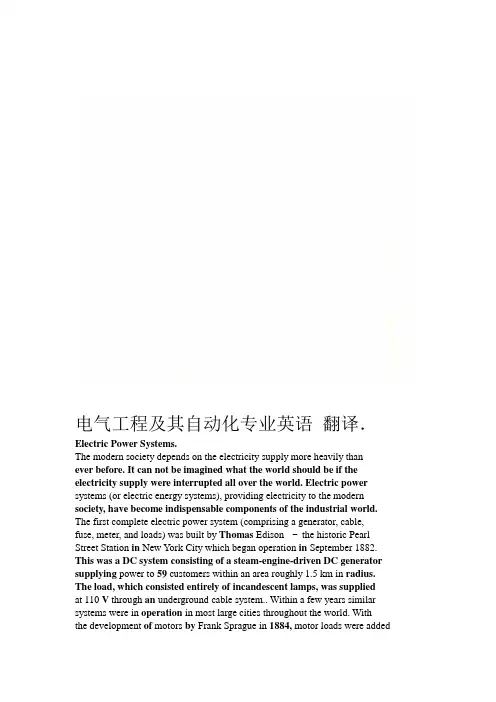
电气工程及其自动化专业英语翻译.Electric Power Systems.The modern society depends on the electricity supply more heavily thanever before. It can not be imagined what the world should be if the electricity supply were interrupted all over the world. Electric power systems (or electric energy systems), providing electricity to the modern society, have become indispensable components of the industrial world. The first complete electric power system (comprising a generator, cable, fuse, meter, and loads) was built by Thomas Edison –the historic Pearl Street Station in New York City which began operation in September 1882. This was a DC system consisting of a steam-engine-driven DC generator supplying power to 59 customers within an area roughly 1.5 km in radius. The load, which consisted entirely of incandescent lamps, was suppliedat 110 V through an underground cable system.. Within a few years similar systems were in operation in most large cities throughout the world. Withthe development of motors by Frank Sprague in 1884, motor loads were addedto such systems. This was the beginning of what would develop into oneof the largest industries in the world. In spite of the initial widespreaduse of DC systems, they were almost completely superseded by AC systems. By 1886, the limitations of DC systems were becoming increasingly apparent. They could deliver power only a short distance from generators. To keep transmission power losses ( I 2 R ) and voltage drops to acceptable levels, voltage levels had to be high for long-distance power transmission. Such high voltages were not acceptable for generation and consumption of power; therefore, a convenient means for voltage transformation became a necessity.The development of the transformer and AC transmission by L. Gaulard and JD Gibbs of Paris, France, led to AC electric power systems. In 1889, the first AC transmission line in North America was put into operation in Oregon between Willamette Falls and Portland. It was a single-phase line transmitting power at 4,000 V overa distance of 21 km. With the development of polyphase systems by Nikola Tesla, the AC system became even more attractive. By 1888, Tesla held several patents on AC motors, generators, transformers, and transmission systems. Westinghouse bought the patents to these early inventions, and they formed the basis of the present-day AC systems. In the 1890s, there was considerable controversy over whether the electric utility industry should be standardized on DC or AC. By the turn of the century, the AC system had won out over the DC system for the following reasons:(1)V oltage levels can be easily transformed in AC systems, thus providing the flexibility for use of different voltages forgeneration, transmission, and consumption.(2)AC generators are much simpler than DC generators.(3)AC motors are much simpler and cheaper than DC motors.The first three-phase line in North America went into operation in 1893.——a 2,300 V, 12 km line in southern California. In the early periodof AC power transmission, frequency was not standardized. This poses a problem for interconnection. Eventually 60 Hz was adopted as standardin North America, although 50 Hz was used in many other countries. The increasing need for transmitting large amounts of power over longer distance created an incentive to use progressively high voltage levels.To avoid the proliferation of an unlimited number of voltages, theindustry has standardized voltage levels. In USA, the standards are 115, 138, 161, and 230 kV for the high voltage (HV) class, and 345, 500 and 765 kV for the extra-high voltage (EHV) class. In China, the voltage levels in use are 10, 35, 110 for HV class, and 220, 330 (only in Northwest China) and 500 kV for EHV class . The first 750 kVtransmission line will be built in the near future in Northwest China. With the development of the AC/DC converting equipment, high voltage DC (HVDC) transmission systems have become more attractive and economical in special situations. The HVDC transmission can be used for transmissionof large blocks of power over long distance, and providing an asynchronouslink between systems where AC interconnection would be impracticalbecause of system stability consideration or because nominal frequenciesof the systems are different. The basic requirement to a power systemis to provide an uninterrupted energy supply to customers with acceptablevoltages and frequency. Because electricity can not be massively storedunder a simple and economic way, the production and consumption ofelectricity must be done simultaneously. A fault or misoperation in anystages of a power system may possibly result in interruption ofelectricity supply to the customers. Therefore, a normal continuousoperation of the power system to provide a reliable power supply to the customers is of paramount importance. Power system stability may bebroadly defined as the property of a power system that enables it to remainin a state of operating equilibrium under normal operating conditionsand to regain an acceptable state of equilibrium after being subjectedto a disturbance.. Instability in a power system may be manifested inmany different ways depending on the system configuration and operatingmode. Traditionally, the stability problem has been one of maintaining synchronous operation. Since power systems rely on synchronous machinesfor generation of electrical power, a necessary condition forsatisfactory system operation is that all synchronous machines remainin synchronism or, colloquially in step. This aspect of stability isinfluenced by the dynamics of generator rotor angles and power-angle relationships, and then referred to rotor angle stability译文:电力系统现代社会比以往任何时候更多地依赖于电力供应。
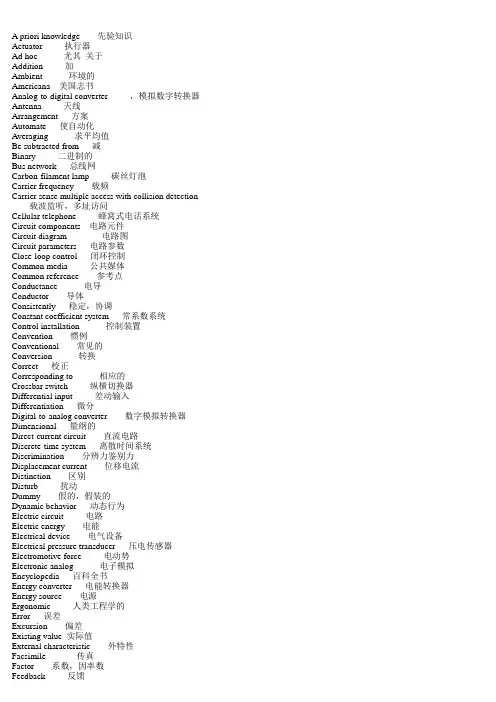
A priori knowledge 先验知识Actuator 执行器Ad hoc 尤其关于Addition 加Ambient 环境的Americana 美国志书Analog-to-digital converter ,模拟数字转换器Antenna 天线Arrangement 方案Automate 使自动化Averaging 求平均值Be subtracted from 减Binary 二进制的Bus network 总线网Carbon-filament lamp 碳丝灯泡Carrier frequency 载频Carrier sense multiple access with collision detection 载波监听,多址访问Cellular telephone 蜂窝式电话系统Circuit components 电路元件Circuit diagram 电路图Circuit parameters 电路参数Close-loop control 闭环控制Common media 公共媒体Common reference 参考点Conductance 电导Conductor 导体Consistently 稳定,协调Constant coefficient system 常系数系统Control installation 控制装置Convention 惯例Conventional 常见的Conversion 转换Correct 校正Corresponding to 相应的Crossbar switch 纵横切换器Differential input 差动输入Differentiation 微分Digital-to-analog converter 数字模拟转换器Dimensional 量纲的Direct-current circuit 直流电路Discrete-time system 离散时间系统Discrimination 分辨力鉴别力Displacement current 位移电流Distinction 区别Disturb 扰动Dummy 假的,假装的Dynamic behavior 动态行为Electric circuit 电路Electric energy 电能Electrical device 电气设备Electrical pressure transducer 压电传感器Electromotive force 电动势Electronic analog 电子模拟Encyclopedia 百科全书Energy converter 电能转换器Energy source 电源Ergonomic 人类工程学的Error 误差Excursion 偏差Existing value 实际值External characteristic 外特性Facsimile 传真Factor 系数,因率数Feedback 反馈Feedback component 反馈元件Frequency counter 频率计数器Frequency-domain 频域Function 功能Generator 发电机Graphic panel 图式仪表盘Heating appliance 电热器High definition television 高清电视Hybrid system 混合系统Ideal amplifier 理想放大器Immunity 不敏感性Income 输入Indicator 指示Inertia 惯性Inertia reference frame 惯性参考坐标系Infinite voltage gain 无穷大电压增益Initial voltage 初始电压Input quantity 输入量Integrated service digital network综合业务数据网Integration 积分Internal combustion engine 内燃机Interruption 阻断Intervention 介入Inverting amplifier 反相放大器Inverting terminal 反相端Linear vector space 线性向量空间Linearization 线性化Load characteristic 负载特性Load resistance 负载特性Logic level 逻辑电平Logistic 后勤的Lower limit on the integration 积分下限Low-order system 低阶系统Low-pass filter 低通滤波器Machine tool 机床Magnetic and electric field 电磁场Manual 手工Manufacturer’s data sheet 铭牌Mathematical operation 数字运算Measuring technique 测试技术Megohm 兆欧Metal-filament lamp 金属丝灯泡Metropolitan area network 城域网Microvolt 微伏Modern control theory 现代控制理论Multiplexer 多路切换器Multiplication 乘Negative-feedback signal 负反馈信号Noise 噪声Noninverting terminal 非反相端Nonlinear 非线性的Off-set 失常点Offset=bias 偏置On-line system 联机系统Ono-linear characteristics 非线性特性Open loop gain 开环增益Open-loop control 开环控制Operational amplifier 运算放大器Optimal control 最优控制Opto-isolator 观点耦合器Order 数量级Outset 开始Parallel digital signal 并行数字信号Pervasive 普遍性的Phase reversal 反相Phase-plane method 像平面方法Potentiometer 电位计Preset 预先装置Primary cell 原生电池Private networks 专业网络Public network 公用网络Radix-weighted 基数加权Rated 额定的Research and design 研发Resolution 分辨力Ring network 环形网Scaling 量程调整Schematic 纲要的Schmitt-trigger 施密特触发器Secondary cell 再生电池Self-(or mutual-) induction 自(互)感Self-acting 自动做Self-moving 自运动Servooperated null-balance potentiometer 伺服驱动零平衡电位差计Shaft encoder 转轴编码的Shunt connection 并联连接Signal conditioning 信号调理Signal conditioning 信号处理Simultaneous equations 联立方程Single-ended output 单端输出Sink 灌入Source 从出来Span 量程Specification 参数Square root extraction 开平方State variable method 状态变量方法Storage battery 蓄电池Strain gage 应变仪Strip chart 长条记录纸Substrate 底层基片Subtraction 减Synchros 感应同步器System buses 系统总线Telecommunication 远程通信Terminal voltage 端电压The dielectric 电介质Time-domain technique 时间域技术Time-invariant 定常的Time-varying parameter 时变参数Timing circuit 计时电路Token 令牌Topology 拓扑Transducer 传感器Transfer function 传递函数Transformer 变压器Triangular symbol 三角符号Uncertainty 不确定性Unidirectional current 单方向性电流Upgrade 升级Virtual 虚的Virtual ground 虚地Voltage drop 电压降Volt-ampere characteristics 伏安特性Wire 导线Zero adjustment 零位调整。
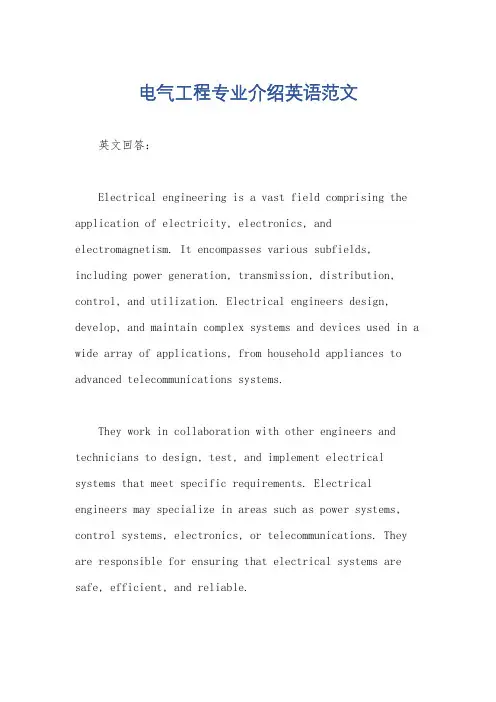
电气工程专业介绍英语范文英文回答:Electrical engineering is a vast field comprising the application of electricity, electronics, and electromagnetism. It encompasses various subfields, including power generation, transmission, distribution, control, and utilization. Electrical engineers design, develop, and maintain complex systems and devices used in a wide array of applications, from household appliances to advanced telecommunications systems.They work in collaboration with other engineers and technicians to design, test, and implement electrical systems that meet specific requirements. Electrical engineers may specialize in areas such as power systems, control systems, electronics, or telecommunications. They are responsible for ensuring that electrical systems are safe, efficient, and reliable.Some of the key responsibilities of electrical engineers include:Designing and developing electrical systems for power generation, transmission, distribution, and control.Designing and installing electrical wiring and equipment for homes, businesses, and industrial facilities.Maintaining and repairing electrical systems and equipment.Troubleshooting electrical problems.Developing and testing new electrical technologies.Electrical engineers play a critical role in the development and maintenance of modern society. They are responsible for the design and operation of the electrical systems that power our homes, businesses, andtransportation systems. They also work in the development of new technologies, such as renewable energy systems andelectric vehicles.中文回答:什么是电气工程?电气工程是应用电、电子、电磁学的广阔领域。
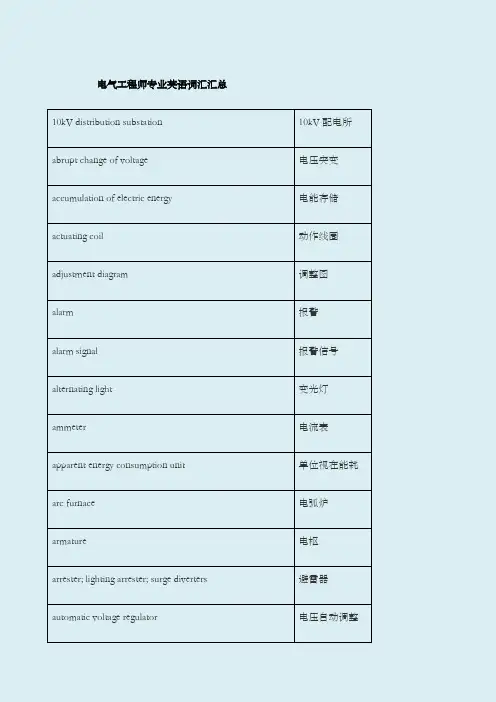
电气工程师专业英语词汇汇总10kV distribution substation10kV配电所abrupt change of voltage电压突变accumulation of electric energy电能存储actuating coil动作线圈adjustment diagram调整图alarm报警alarm signal 报警信号alternating light变光灯ammeter电流表apparent energy consumption unit单位视在能耗arc furnace电弧炉armature电枢arrester; lighting arrester; surge diverters 避雷器automatic voltage regulator电压自动调整器backlighting; background illumination背景照明battery box电池箱battery charger电池充电器battery contactor电池接触器battery fuse电池保险丝battery resistor电池电阻器blow-out coil磁吹线圈boom吊杆bracket (OCS)底座(接触网);支架;托架bracket for headspan wire定位索底座bridge电桥brush电刷built-in wardrobe; built-in closet; closet壁灯bulb; light(lamp) bulb; electric bulb灯泡butterfly valve with electric actuator电动蝶阀button电钮cable and accessories电缆及附件cable armour电缆铠装cable bays电缆电线间隔cable box电缆箱cable bracket; cable tray电缆托架cable continuity test电路复测cable differential protection电缆差动保护cable distribution cabinets (CDCs)电缆分线箱(电缆分歧箱)cable drum电缆盘cable duct cable conduit电缆管道cable duct; cable trench电缆沟cable end; cable lug电缆端头cable fault locator电缆故障探测仪cable gallery电缆廊道cable hanger; cable suspender电缆吊架cable laying laying of cables电缆敷设cable marking电缆标志cable rack电缆架cable shaft电缆竖井cable sleeve; electrical wire conduit电缆套管cable support电缆支架cable tapping box电缆分接箱cable terminal电缆终端cable terminal box电缆盒cable tray电缆托架cable trenches with chequer plates带方形盖板的电缆沟槽cable trough电缆沟槽cable trough; trough电缆槽cable tunnel; cable-subway电缆隧道cable vault电缆室cable work电缆厂capacitance电容capacitance compensation电容补偿capacitive charges电容电荷capacitive voltage transformer电容式电压互感器capacitor电容器capacitor bank电容器组capacitor compensator 电容补偿器capacitor coupling电容耦合capacitor filtering电容滤波catenary/messenger承力索catenary; messenger wire; catenary wire承力索ceiling lamp ceiling light顶灯ceramic wall bushings穿墙套管changeover box电源切换箱changeover box for smoke curtain挡烟垂幕电源切换箱circuit电路circuit connection电路接线circuit diagram电路图circuit diagrams电路图circuit diagrams电路图circuit parameter电路参数circuit-breaker unit断路器单元closed circuit闭路closed circuit TV (CCTV)闭路电视cod for electrical design and installation电气设计安装规范coefficient of resistivity电阻系数compensation补偿compensation reactor 补偿电抗器concealed piping; concealed pipe暗管concealed wiring; concealed electric wiring 暗线condenser电容器condenser bank(block)电容器组condenser charge电容器充电condenser discharge电容器放电condenser reactance电容器电抗conductor导线conductor rail导电轨conductor resistance导体电阻contact触头continuous carrying capacity 持续载流能力corona电晕cross-span drop bracket定位索定位支座current & voltage transducer电流电压变换器current amplification电流放大current relay电流继电器current relay电流继电器current transformer (CT)电流互感器de-energize断电diesel generator; diesel dynamo柴油发电机diesel power plant; diesel generating station柴油发电站differential protection差动保护differential protection cables 差动保护电缆differential relay差动继电器digital format电子文档direct feeding system with return cable带回流线的直接供电方式(TRNF供电方式)directional coil定向线圈directional coupler定向耦合器directional lighting定向照明dispatching centre; load dispatching centre; control centre 调度中心display lighting陈列品照明district transformer station and distribution center地区变、配电所drawer抽屉柜drawout design抽出式设计drop bracket吊架drop bracket定位单环, 定位支座dummy load; equivalent load等效负载duration of short-circuit短路电流(持续) 时间dust尘埃dynamic analysis method动态法dynamic inductance动态电感elastic support structure弹性支座结构ELE (elevator)电梯electric bell电铃electric coupler 电器连接electric displacement电位移electric equipment inspection railcar电气检测车electric hoist (block)电动葫芦electric horn电喇叭electric installation drawing电气图纸electric joint电气分断点electric potential电势electric power fitting 电力金具electric railway电气铁道electric resistance; resistivity电阻率electric siren电笛electric system电气系统electric traction电力牵引electric traction feeding system电力牵引供电系统electric traction telemechanical system电力牵引远动系统electrical apparatus for explosive atmospheres 爆炸环境用电气设备electrical design电气设计electrical diagrams电气图electrical energy电能electrical equipment (appliance)电器electrical experimental equipment电工实验设备electrical installation; electrical fitting电气安装electrical lamp; electric light电灯electrical maintenance case电器维修箱electrical outlet电气出线口electrical rating电气额定值electrician电工electrification电气化electrification interference 电气化干扰electrification interference电气化干扰electrified railway电气化铁路electrified railway remodeling电气化铁道改造, 电气化铁路改造electrified track电气化铁道electromaginetic induction电磁感应electromagnetic relay电磁继电器electronic AC stabilizer电子交流稳压器electronic information processing电子信息处理electroplated coating of zinc电镀锌emergency battery备用电池energy transmission电能传输exit light安全出口灯factory site; location of factory场致发光灯fall of current电流下降fall of voltage电压下降fastening blacket抱箍fiber glass steel 玻璃钢floor special purpose receptacle地面专用插座fluorescent lamp ballast with emergency function带应急功能的荧光灯镇流器fly light gallery灯光天桥frequency-modulated, digital telegram调频数字电报galvanized iron wire strands 镀锌钢绞线galvanized steel sheet镀锌钢管galvanometer; rheometer; current meter电流计glass reinforced plastic玻璃纤维加劲塑料ice冰雪impulse current冲击电流incandescent lamp base白炽灯灯头incandescent lamp; incandescent filament lamp白炽灯incandescent lighting白炽灯照明inductance 电感inductance-capacitance meter电感器industrial frequency AC electric traction system单相工频交流电力牵引制inner covering电缆内护层inner covering; bedding sheath电缆内套insulation window保温窗intensity of current电流强度interrupter; circuit breaker; breaker断路器,续断器interruption of current断路isolux curve等照度曲线kilowatt-hour meter; watt-hour meter; electric meter电能表lamination叠片lamp bridge灯桥lamp socket; lamp holder; lamp base灯座lamp; light; lantern灯lamplight; lighting灯光lamps; lighting fixtures灯具lampshade lamp cover灯罩leading超前lead-out出线life terminal带电端子light control灯光控制light trough; light slot; troffer灯槽lighthouse beacon; pharos灯塔lighting standard; lighting post; lighting pole灯柱lightning protection避雷(防雷)lightning rod,lightning conductor避雷针little poisonous低毒little poisonous低毒live带电live带电live equipment 带电设备live working 带电作业local power supply地方电源low frequency低频low smoke zero halogen cable低烟无卤电缆low -voltage cable低压电缆low voltage circuit低压电路low -voltage control低压控制low -voltage power distribution box低压配电箱low -voltage protection低压保护low -voltage switch低压开关low -voltage switch cabinet低压开关柜low-term overvoltage短时过电压low-voltage switchgear 低压成套开关magnetic switch磁力开关magnitude of voltage电压值mains side电流侧mains switch电源开关mains transformer电源变压器mains voltage电源电压making capacity闭合容量marker lamp标志灯mild steel conduct rail; mild steel third rail低碳钢接触轨modulator-demodulator (modem) 调制解调器motor-generator set电动发电机组moving contact动触头network command centre (NCC)电网指挥中心nominal value标称值nominal voltage 标称电压notch-off断电ohmic loss电阻损失one-way circuit单相电路one-way feeding单边供电open circuit breaker; cutout; circuit breaker (CB)断路器open-circuit arc断路电弧open-delta connection V形接法open-phase protection断相保护装置operating system (OS)操作系统operation of network电网运行管理operation passageway操作走廊outlet出线口outlet出线口outlet box出线盒outlet box出线盒overhead illumination; overhead lighting; top lighting顶部照明panel; board电屏parallel circuit; shunt circuit并联电路parallel connection; shunt connection并联parallel resistance 并联电阻patch board; patch插头板PE (protective earth)保护地pendant continuous row fluorescent fixture吊装荧光灯带pendent(pendant) lamp ; drop light吊灯permanent lighting 常设照明phasing device定相器point to point configuration 点对点配置point welding machine点焊机port端口potential电位potential difference电位差potential fall; voltage drop电压降potential rise电压升potential transformer; inductive voltage transformer电压互感器电压互感器potential transformer; pressure transformer; voltagetransformerpower administration电业管理局power cable电力电缆power cable well电力电缆井power car 动力车辆power control box动力控制箱power dispatch电力调度power dispatcher电调power lighting transformer feeder cubicle动力变压器馈电柜power line harmonic current interference电力线谐波干扰power source电源power source bay电源间隔power source for indication lamp表示灯电源power supply cabinet动力柜power supply cable电力供电电缆power supply cable电源线power supply of electric traction system电力牵引供电系统电源power supply panel电源屏power supply plug电源插头power supply room电源室power transformer substation; substation (SS)动力变电所power transformers energy saving operation电力变压器经济运行power transmission电能输送power-line carrier channel; PLC-channel 电力线载波通道principle of superposition叠加原理private wire测试线protection panel保护屏protective cable保护电缆protective circuit保护电路protective equipment of secondary circuit of power system 电力系统二次回路控制装置protective?wire保护线push button switch; push button; button switch按钮开关push-button按钮push-button control; button control按钮控制reactance电抗reactive current电抗性电流reactive drop电抗性电压降Reactors 电抗器reference electrode参考电极registration device定位装置registration wire定位索resistance 电阻resistance value电阻值resistivity电阻率rheostatic control 变阻调速safety lighting安全照明safety voltage安全电压SCA (supervisory control and data acquisition)电力监控系统sectioning电分段sectioning电分段sectioning?point电分段装置semi-autotensioned catenary equipment半补偿链形悬挂semidirect lighting半直接照明series battery串联电池组series circuit串联电路series connection串联series-parallel circuit串并联short circuit短路short circuit calculation短路计算short circuit detection transformer短路监视互感器short-circuit current短路电流short-circuit current短路电流short-circuit current capacity短路载流量short-circuit current setting calculation短路电流整定计算short-circuit failure 短路故障short-circuit impedance短路阻抗short-circuit loss短路损耗short-circuit protection短路保护装置short-circuiter短路器short-time load短时负载show-window lighting橱窗照明shunt capacitors并联电容sign illumination system标志照明系统simple (catenary) equipment system with single contact wire单接触线的简单链形悬挂single arm pantograph单臂受电弓single core cable PVC jacket单芯电缆PVC套single power supply单电源single-phase motor单相电动机single-phase system单相系统single-phase two-wire system单相两线制single-throw switch单投开关slide-in (unit)抽屉式socket; outlet; receptacle插座spare fuses备用保险丝spotlight; spot lamp点光源stainless steel running face不锈钢化性接触面standard light source标准光源stand-by generator; reserved generator备用发电机stand-by lighting备用照明stand-by power source备用电源star-delta connection Y-△接线start pulse触发脉冲stitched catenary suspensic弹性链形悬挂stitched catenary suspension弹性链形悬挂stitched tramway type equipment弹性简单悬挂strong current test panel (including rectifying and voltage regulating)大电流测试(含整流; 高压) 电源屏sub-distribution box动力配电箱sub-distribution box for elevator电梯配电箱superimposed load超载superimposed load叠加荷载supper-low voltage circuit超低压电路surge arrester 电涌放电器switching-surge操作过电压tagging标签telephone interference电话干扰tensioning equipment/tensioning device/tensioner补偿器terminal端子terminal block端子板terminal block端子排terminal box端子箱terminal box端子箱terminal insulator端子绝缘terminal linkage board端子连接板terminal of the cable linking box 电缆连接箱端子terminal point gun端子连接器terminals for power supply电源端子The trigger contains materials and equipment that are considered to be controlled commodities that either cannot be exported or that require an expert license. The list is an up-to date database maintained by Oak Ride National Laboratory (ORNZ) and has interactive search capacities. The list contains brief subject identifiers; you can “click”on a particular item to acquire detailed specifications.出口材料和商品受控单time switch定时开关traction transformer for single-phase V,V.connection单相V,V.结线牵引变压器traction transformer of single-phase connection单相结线牵引变压器transformer 动力变压器transformer bank变压器组transformer box变压器箱transformer capacity变压器容量transformer coupling变压器耦合transformer pole变压器杆transformer protection panel变压器保护屏transformer station; substation变电所transmitting relay传输继电器twin bracket定位双环underground cable terminal box地中电缆盒underground cable; ground cable地下电缆uninterrupted power supply (UPS)不间断电源(UPS)valve amplifier电子管放大器vital aspect安全显示voltage amplification电压放大voltage below level电压过低voltage distortion电压畸变率voltage drop 电压损失voltage limiter电压限制器(限压器)voltage regulator调压器voltage unbalance电压不平衡度voltmeter电压表wall lamp; bracket light壁灯washer垫圈watt-hour meter; kilowatt-hour meter; electric meter电表workshop power supply车间电源workshop power supply车间供电zinc-clad steel strand wire镀锌钢绞线1. Personnel 人员职员2. Voltmeter 电压表伏特计3. Ohmmeter 欧姆计电阻表4. Megohmmeter 兆欧表5. Wattmeter 瓦特计电表功率6. Watt-hour 瓦时瓦特小时7. Ammeter 安培计电流表8. calibrate 校正9. scale 刻度量程10. rated 额定的11. interfere with 有害于。
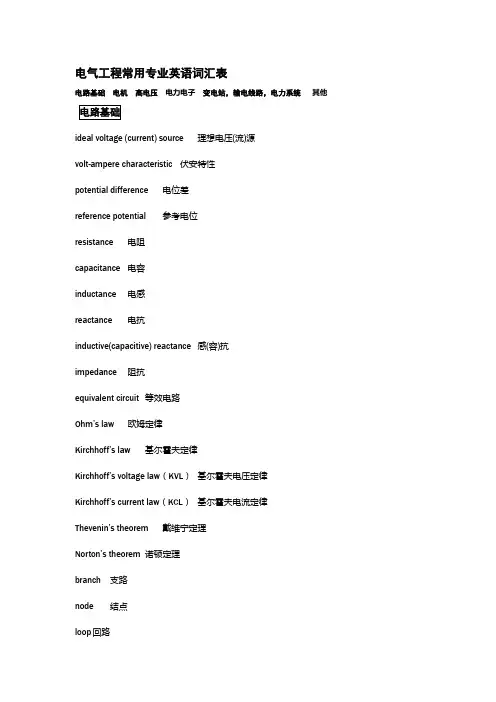
电气工程常用专业英语词汇表电路基础电机高电压电力电子变电站,输电线路,电力系统其他ideal voltage (current) source 理想电压(流)源volt-ampere characteristic 伏安特性potential difference 电位差reference potential 参考电位resistance 电阻capacitance 电容inductance 电感reactance 电抗inductive(capacitive) reactance 感(容)抗impedance 阻抗equivalent circuit 等效电路Ohm’s law欧姆定律Kirchhoff’s law基尔霍夫定律Kirchhoff’s voltage law(KVL)基尔霍夫电压定律Kirchhoff’s current law(KCL)基尔霍夫电流定律Thevenin’s theorem戴维宁定理Norton’s theorem诺顿定理branch 支路node 结点loop 回路mesh 网孔open circuit 开路(断路)short circuit 短路branch current analysis 支路电流法mesh current analysis 网孔电流法ode voltage analysis 结点电位法nsuperposition theorem 叠加原理passive(active) two-terminal network 无(有)源二端网络root mean square (RMS) 均方根值effective value 有效值instantaneous value 瞬时值ampere 安培volt 伏特Hertz 赫兹reactive power` 无功功率active power 有功功率transfer function 传递函数apparent power 视在功率power-factor compensation 功率因数补偿series (parallel) resonance 串(并)联谐振amplitude(phase)-frequency response characteristic 幅(相)频特性figure of merit 品质因素pass-band 通频带bandwidth (BW) 带宽first(second)-order filter 一(二)阶滤波器low(high)-pass filter 低(高)通滤波器band-pass(stop) filter 带通(阻)滤波器transfer function 转移函数Bode diagram 波特图Fourier series 傅立叶级数three-phase circuit 三相电路cutoff frequency 截止频率FFT (Fast Fourier Transform) 快速傅立叶变换state variable 状态变量generation 发电transmission 输电distribution 配电coil 线圈core 铁心winding 绕组electrical machine 电机generator 发电机motor 电动机stator (rotor) 定子(转子)armature 电枢brush 电刷commutator 换向器salient-pole 凸极slip ring 滑环induction motor 感应电动机magnetic flux 磁通asynchronous machine 异步电机synchronous generator 同步发电机eddy current 涡流EMF(electromotive force)电动势counter EMF 反电势torque 转矩excitation 励磁prime mover 原动机rectifier 整流器leakage flux 漏磁通demagnetization 退磁,去磁short-circuit ratio 短路比converter (inverter) 换流器(逆变器)synchronous condenser 同步调相机magnetization curve 磁化曲线separately exciting 他励compounded excited 复励self-exciting 自励series(shunt)-wound 串(并)励bearing 轴承Extra-high voltage (EHV) 超高压Ultra-high voltage (UHV) 特高压insulation 绝缘overvoltage 过电压lightning arrester 避雷器metal oxide arrester MOA 氧化锌避雷器Insulator 绝缘子circuit breaker CB 断路器vacuum circuit breaker 真空断路器earth(ground) wire 接地线grading ring 均压环aging 老化arc discharge 电弧放电breakdown (电)击穿Dielectric 电介质,绝缘体corona 电晕dielectric constant 介质常数dielectric loss 介质损耗divider ratio 分压器分压比electric field 电场field strength 场强field stress 电场力field distortion 场畸变field gradient 场梯度flashover 闪络gaseous (solid ,liquid) insulation 气(固,液)体绝缘space charge 空间电荷shielding 屏蔽routing testing 常规试验rating of equipment 设备额定值polarity effect 极性效应non-destructive testing 非破坏性试验partial discharge 局部放电impulse current 冲击电流impulse flashover 冲击闪络uniform field 均匀场inhomogenous field 不均匀场insulation coordination 绝缘配合internal discharge 内部放电lightning stroke 雷电波non-uniform field 不均匀场streamer breakdown 流注击穿short circuit testing 短路试验space charge 空间电荷surface breakdown 表面击穿sustained discharge 自持放电switching overvoltage 操作过电压lightning overvoltage 雷电过电压withstand voltage 耐受电压wave front(tail) 波头(尾)Schering bridge 西林电桥point plane gap 针板间隙composite insulator 合成绝缘子recovery voltage 恢复电压restriking 电弧重燃rated voltage(current) 额定电压(电流)oil-impregnated paper 油浸纸绝缘XLPE(Cross Linked Polyethylene ) 交联聚乙烯(电缆)volt-time characteristics 幅秒特性partial discharge 局部放电switchgear 开关装置temporary overvoltages 暂态过电压peak voltmeter 峰值电压表cascade transformer 串级变压器coupling capacitor 耦合电容test object 被试品detection impedance 检测阻抗Dissolved Gas Analysis (DGA) 溶解气体分析voltage divider 分压器regulator 调压器electrostatic voltmeter 静电电压表impulse current (voltage) generator 冲击电流(压)发生器online monitoring 在线监测preventive test 预防性试验test object 被试品operation amplifier 运算放大器active (passive )filter 有(无)源滤波器Uninterruptible Power Supply 不间断电源analytical 解析的numerical 数字的frequency-domain 频域time-domain 时域operation amplifier 运算放大器amplitude modulation (AM) 调幅frequency modulation (FM) 调频integrated circuit (IC) 集成电路semiconductor 半导体diode 二极管thyristor 晶闸管transistor 晶体管triac 双向可控硅silicon 硅crystal 晶体anode 阳极cathode 阴极collector 集电极emitter 发射极capability 容量horseppower 马力modulation 调制demodulation 解调analog electronics 模拟电子学digital electronics 数字电子学analog to digital conversion (ADC) 模数转换oscilloscope 示波器invertering (uninvertering)amplifier 反(同)相放大器feedback 反馈feedforward 前馈open (closed) loop 开(闭)环signal to noise ratio (SNR) 信噪比transistor to transistor logic (TTL) 晶体管-晶体管逻辑light emitting diode (LED) 发光二极管power supply 电源power system 电网voltage 电压current 电流alternating current ( AC) 交流direct current (DC) 直流transformer 变压器power transformer 电力变压器step-up(down) transformer 升(降)压变压器bushing 套管high voltage 高压low voltage 低压middle voltage 中压no-load loss 空载损耗neutral point 中性点iron loss 铁损copper loss 铜损turn (turn ratio) 匝(匝比,变比)tap 分接头outgoing (incoming) line 出(进)线power transmission system 输电系统transmission line 输电线phase-to-phase (line) voltage 线电压phase voltage 相电压substation 变电站bus bar 母线potential transformer PT 电压互感器current transformer CT 电流互感器disconnect switch 隔离开关earthing switch 接地开关rogowski coil 罗可夫斯基线圈oscilloscope 示波器surge impedance 波阻抗grounding capacitance 对地电容arc suppression coil 消弧线圈power factor 功率因数steel-reinforced aluminum conductor 钢芯铝绞线radio interference 无线干扰primary(backup) relaying 主(后备)继电保护protective relaying 继电保护skin effect 集肤效应series (shunt) compensation 串(并)联补偿tidal current 潮流blackout 断电、停电margin 裕度fault 故障three phase fault 三相故障surge 冲击damping 阻尼Load shedding 甩负荷voltage grade 电压等级positive sequence impedance 正序阻抗negative sequence impedance 负序阻抗zero sequence impedance 零序阻抗phase lead(lag) 相位超前(滞后)Shunt reactor 并联电抗器neutral line 中线transient state 暂态steady state 稳态Phase displacement (shift) 相移symmetrical three-phase source(load)对称三相电源(负载) three-phase three(four)-wire system 三相三(四)线制star connection(Y-connection) 星形连接triangular connection(D- connection ,delta connection) 三角形连接zero sequence current 零序电流underground cable 地下电缆capacity 容量subnet 子网primary (secondary)winding 一次(二次)线圈,原(副)边servomechanism 伺服系统oscillatory 摆动的nameplate 铭牌harmonic 谐波damped 阻尼的conductor 导线overhead line 架空线transmission line 传输线Electrical Machinery 电机学Automatic Control Theory 自动控制理论Electromagnetic Field 电磁场Principle of Microcomputer 微机原理Electrotechnics 电工学Principle of circuits 电路原理Steady-State Analysis of Power System 电力系统稳态分析Transient-State Analysis of Power System 电力系统暂态分析Principle of Electrical System's Relay Protection 电力系统继电保护原理Protection Principle of Power System 's Element 电力系统元件保护原理Basic fundamentals of power electronics 电力电子基础Analogue Electronic Technique 模拟电子技术Digital Electrical Technique 数字电子技术High voltage engineering 高电压工程Introduction to electrical engineering 电气工程概论highvoltage testing technology 高电压试验技术Electrical Drive and Control 电力传动与控制Power System Relaying Protection 电力系统继电保护Power electronics 电力电子EMC(electromagnetic compatibility) 电磁兼容servomechanism 伺服系统static (state) 静态dynamic (state) 动态resonance 谐振,共振fuse 保险丝,熔丝scale 刻度,量程rated 额定的modulator 调制器demodulator 解调器terminal 接线端子calibrate 校准IEEE (Institute of Electrical and Electronic Engineers) 电气与电子工程师学会(美)IEE (Institution of Electrical Engineers) 电气工程师学会(英)IEC (international Electrotechnical Commission) 国际电工(技术)委员会ripple 纹波wide area network (WAN) 广域网local area network (LAN) 局域网voltmeter 伏特表ohmmeter 欧姆表wattmeter 瓦特表ammeter 安培表multimeter 万用表sensor 传感器transducer 传感器,变换器。

电气工程及其自动化专业英语翻译Last revision on 21 December 2020Semiconductor switches are very important and crucial components in power electronic switches are meant to be the substitutions of the mechanical switches,but they are severely limited by the properties of the semiconductor materials and process of manufacturing. 在电力电子系统,中半导体开关是非常重要和关键部件。
半导体开关将要替换机械开关,但半导体材料的性质和生产过程严重限制了他们。
Switching losses开关损耗Power losses in the power eletronic converters are comprised of the Switching losses and parasitic losses. 电力电子转换器的功率损耗分为开关损耗和寄生损耗the parasitic losses account for the losses due to the winding resistances of the inductors and transformers,the dielectric losses of capacitors,the eddy and the hysteresis losses. 寄生损失的绕组电感器、变压器的阻力、介电损耗的电容器,涡流和磁滞损耗the switching losses are significant and can be managed. 这个开关损耗是非常重要的,可以被处理。
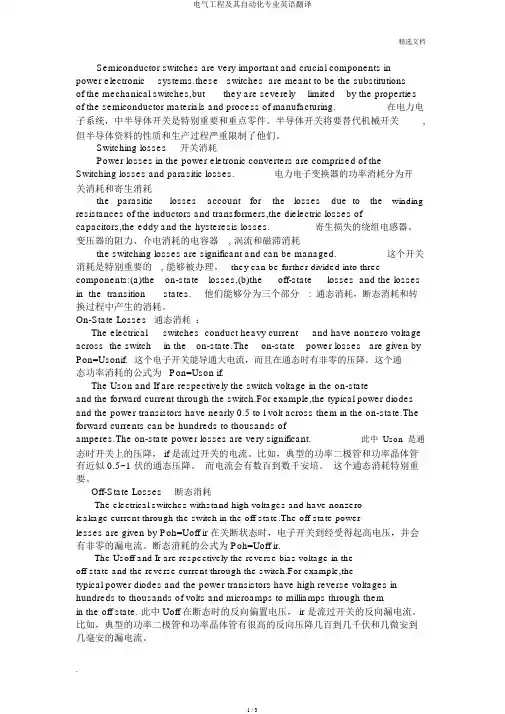
Semiconductor switches are very important and crucial components inpower electronic systems.these switches are meant to be the substitutionsof the mechanical switches,but they are severely limited by the properties of the semiconductor materials and process of manufacturing.在电力电子系统,中半导体开关是特别重要和重点零件。
半导体开关将要替代机械开关,但半导体资料的性质和生产过程严重限制了他们。
Switching losses开关消耗Power losses in the power eletronic converters are comprised of the Switching losses and parasitic losses.电力电子变换器的功率消耗分为开关消耗和寄生消耗the parasitic losses account for the losses due to the winding resistances of the inductors and transformers,the dielectric losses ofcapacitors,the eddy and the hysteresis losses.寄生损失的绕组电感器、变压器的阻力、介电消耗的电容器, 涡流和磁滞消耗the switching losses are significant and can be managed.这个开关消耗是特别重要的, 能够被办理。
they can be further divided into three components:(a)the on-state losses,(b)the off-state losses and the losses in the transition states.他们能够分为三个部分:通态消耗,断态消耗和转换过程中产生的消耗。
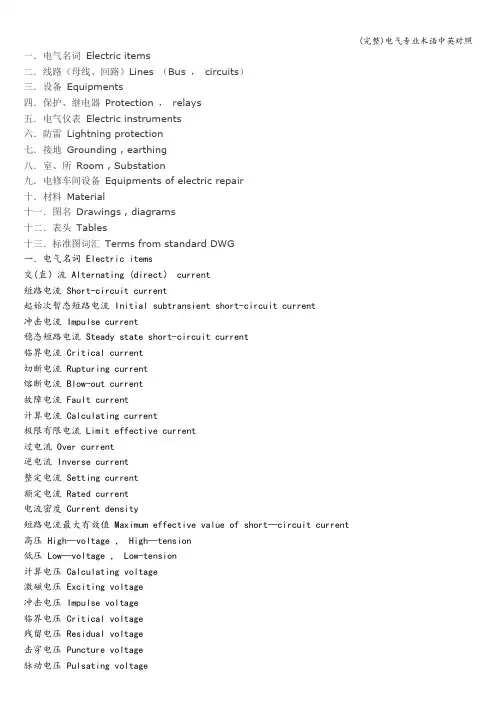
一.电气名词Electric items二.线路(母线、回路)Lines (Bus ,circuits)三.设备Equipments四.保护、继电器Protection ,relays五.电气仪表Electric instruments六.防雷Lightning protection七.接地Grounding , earthing八.室、所Room , Substation九.电修车间设备Equipments of electric repair十.材料Material十一.图名Drawings , diagrams十二.表头Tables十三.标准图词汇Terms from standard DWG一.电气名词 Electric items交(直)流 Alternating (direct) current短路电流 Short-circuit current起始次暂态短路电流 Initial subtransient short-circuit current冲击电流 Impulse current稳态短路电流 Steady state short-circuit current临界电流 Critical current切断电流 Rupturing current熔断电流 Blow-out current故障电流 Fault current计算电流 Calculating current极限有限电流 Limit effective current过电流 Over current逆电流 Inverse current整定电流 Setting current额定电流 Rated current电流密度 Current density短路电流最大有效值 Maximum effective value of short—circuit current 高压 High—voltage , High—tension低压 Low—voltage , Low-tension计算电压 Calculating voltage激磁电压 Exciting voltage冲击电压 Impulse voltage临界电压 Critical voltage残留电压 Residual voltage击穿电压 Puncture voltage脉动电压 Pulsating voltage供电电压 Supply voltage电力电压 Power voltage照明电压 Lighting voltage灯丝电压 Filament voltage额定电压 Rated voltage电压损失 Voltage loss过(欠)电压 Over (under) voltage线路电压 Line voltage电压降 Voltage drop工作电压 Working voltage一次电压 Primary voltage二次电压 Secondary voltage电源 Electric source (power supply)自控电压 Power supply for process control6kV控制闪光电源 Flashing supply for 6kV control 工作电源 Working power supply (electric source)保安电源 Emergency power supply (electric source)直流稳压电源 Stabilized D。
专业英语电路基础characterize描绘…的特征,塑造人物,具有….的特征property 性质,财产equal in magnitude to 在数量(数量级)上等同于convert 转换converter 转换器time rate 时间变化率mathematically 从数学上来讲differen tiate v 区分,区别in honor of 为纪念某人name in honor of为纪念某人而以他命名electromotive force (e m f )电动势voltaic battery 伏打电池,化学电池an element 一个电器元件interpret 口译,解释,说明the potential at point a with respect to point b is点a关于点b的电势Potential difference/voltage 电势差/电压expend 花费,消耗instantaneous 瞬时的,促发的passive sign convention 关联参考方向the law of conservation of energy 能量守恒定律reference polarity 参考极性electron 电子electronic 电子的electric 电的,电动的time—varying 时变的constant-valued 常量的metal lic 金属的be due to 是因为,由于,归功于building block 模块Coulomb库伦,Ampere安培,joule焦耳,Volt伏特,Watt瓦特,work 功变量u(t),i(t)是电路中最基本的概念.他们描述了电路中的各种关系。
电荷量的概念是解释电现象的基本原理,电荷量也是电路中最基本的量。
电荷也是构成物质的原子的电器属性,量纲是库伦.我们从初等物理可以得知所有物质是由基本组成部分原子组成,而原子又包括电子(electron),质子(proton)和中子(neutron)我们都知道电荷e是带负电的电子,在数量上等于1.60210*1019 C, 而质子携带同等电荷量的正电荷,相同数量的质子,电子使原子呈现电中性(neutrally charged).我们细想一下电荷的流动,电荷或电流的一个特征就是它是可移动的,就是说从一个地方以能量转换的形式转移到另外一个地方。
电气工程师专业英语词汇汇总10kV distribution substation10kV配电所abrupt change of voltage电压突变accumulation of electric energy电能存储actuating coil动作线圈adjustment diagram调整图alarm报警alarm signal 报警信号alternating light变光灯ammeter电流表apparent energy consumption unit单位视在能耗arc furnace电弧炉armature电枢arrester; lighting arrester; surge diverters 避雷器automatic voltage regulator电压自动调整器backlighting; background illumination背景照明battery box电池箱battery charger电池充电器battery contactor电池接触器battery fuse电池保险丝battery resistor电池电阻器blow-out coil磁吹线圈boom吊杆bracket (OCS)底座(接触网);支架;托架bracket for headspan wire定位索底座bridge电桥brush电刷built-in wardrobe; built-in closet; closet壁灯bulb; light(lamp) bulb; electric bulb灯泡butterfly valve with electric actuator电动蝶阀button电钮cable and accessories电缆及附件cable armour电缆铠装cable bays电缆电线间隔cable box电缆箱cable bracket; cable tray电缆托架cable continuity test电路复测cable differential protection电缆差动保护cable distribution cabinets (CDCs)电缆分线箱(电缆分歧箱)cable drum电缆盘cable duct cable conduit电缆管道cable duct; cable trench电缆沟cable end; cable lug电缆端头cable fault locator电缆故障探测仪cable gallery电缆廊道cable hanger; cable suspender电缆吊架cable laying laying of cables电缆敷设cable marking电缆标志cable rack电缆架cable shaft电缆竖井cable sleeve; electrical wire conduit电缆套管cable support电缆支架cable tapping box电缆分接箱cable terminal电缆终端cable terminal box电缆盒cable tray电缆托架cable trenches with chequer plates带方形盖板的电缆沟槽cable trough电缆沟槽cable trough; trough电缆槽cable tunnel; cable-subway电缆隧道cable vault电缆室cable work电缆厂capacitance电容capacitance compensation电容补偿capacitive charges电容电荷capacitive voltage transformer电容式电压互感器capacitor电容器capacitor bank电容器组capacitor compensator 电容补偿器capacitor coupling电容耦合capacitor filtering电容滤波catenary/messenger承力索catenary; messenger wire; catenary wire承力索ceiling lamp ceiling light顶灯ceramic wall bushings穿墙套管changeover box电源切换箱changeover box for smoke curtain挡烟垂幕电源切换箱circuit电路circuit connection电路接线circuit diagram电路图circuit diagrams电路图circuit diagrams电路图circuit parameter电路参数circuit-breaker unit断路器单元closed circuit闭路closed circuit TV (CCTV)闭路电视cod for electrical design and installation电气设计安装规范coefficient of resistivity电阻系数compensation补偿compensation reactor 补偿电抗器concealed piping; concealed pipe暗管concealed wiring; concealed electric wiring 暗线condenser电容器condenser bank(block)电容器组condenser charge电容器充电condenser discharge电容器放电condenser reactance电容器电抗conductor导线conductor rail导电轨conductor resistance导体电阻contact触头continuous carrying capacity 持续载流能力corona电晕cross-span drop bracket定位索定位支座current & voltage transducer电流电压变换器current amplification电流放大current relay电流继电器current relay电流继电器current transformer (CT)电流互感器de-energize断电diesel generator; diesel dynamo柴油发电机diesel power plant; diesel generating station柴油发电站differential protection差动保护differential protection cables 差动保护电缆differential relay差动继电器digital format电子文档direct feeding system with return cable带回流线的直接供电方式(TRNF供电方式)directional coil定向线圈directional coupler定向耦合器directional lighting定向照明dispatching centre; load dispatching centre; control centre 调度中心display lighting陈列品照明district transformer station and distribution center地区变、配电所drawer抽屉柜drawout design抽出式设计drop bracket吊架drop bracket定位单环, 定位支座dummy load; equivalent load等效负载duration of short-circuit短路电流(持续) 时间dust尘埃dynamic analysis method动态法dynamic inductance动态电感elastic support structure弹性支座结构ELE (elevator)电梯electric bell电铃electric coupler 电器连接electric displacement电位移electric equipment inspection railcar电气检测车electric hoist (block)电动葫芦electric horn电喇叭electric installation drawing电气图纸electric joint电气分断点electric potential电势electric power fitting 电力金具electric railway电气铁道electric resistance; resistivity电阻率electric siren电笛electric system电气系统electric traction电力牵引electric traction feeding system电力牵引供电系统electric traction telemechanical system电力牵引远动系统electrical apparatus for explosive atmospheres 爆炸环境用电气设备electrical design电气设计electrical diagrams电气图electrical energy电能electrical equipment (appliance)电器electrical experimental equipment电工实验设备electrical installation; electrical fitting电气安装electrical lamp; electric light电灯electrical maintenance case电器维修箱electrical outlet电气出线口electrical rating电气额定值electrician电工electrification电气化electrification interference 电气化干扰electrification interference电气化干扰electrified railway电气化铁路electrified railway remodeling电气化铁道改造, 电气化铁路改造electrified track电气化铁道electromaginetic induction电磁感应electromagnetic relay电磁继电器electronic AC stabilizer电子交流稳压器electronic information processing电子信息处理electroplated coating of zinc电镀锌emergency battery备用电池energy transmission电能传输exit light安全出口灯factory site; location of factory场致发光灯fall of current电流下降fall of voltage电压下降fastening blacket抱箍fiber glass steel 玻璃钢floor special purpose receptacle地面专用插座fluorescent lamp ballast with emergency function带应急功能的荧光灯镇流器fly light gallery灯光天桥frequency-modulated, digital telegram调频数字电报galvanized iron wire strands 镀锌钢绞线galvanized steel sheet镀锌钢管galvanometer; rheometer; current meter电流计glass reinforced plastic玻璃纤维加劲塑料ice冰雪impulse current冲击电流incandescent lamp base白炽灯灯头incandescent lamp; incandescent filament lamp白炽灯incandescent lighting白炽灯照明inductance 电感inductance-capacitance meter电感器industrial frequency AC electric traction system单相工频交流电力牵引制inner covering电缆内护层inner covering; bedding sheath电缆内套insulation window保温窗intensity of current电流强度interrupter; circuit breaker; breaker断路器,续断器interruption of current断路isolux curve等照度曲线kilowatt-hour meter; watt-hour meter; electric meter电能表lamination叠片lamp bridge灯桥lamp socket; lamp holder; lamp base灯座lamp; light; lantern灯lamplight; lighting灯光lamps; lighting fixtures灯具lampshade lamp cover灯罩leading超前lead-out出线life terminal带电端子light control灯光控制light trough; light slot; troffer灯槽lighthouse beacon; pharos灯塔lighting standard; lighting post; lighting pole灯柱lightning protection避雷(防雷)lightning rod,lightning conductor避雷针little poisonous低毒little poisonous低毒live带电live带电live equipment 带电设备live working 带电作业local power supply地方电源low frequency低频low smoke zero halogen cable低烟无卤电缆low -voltage cable低压电缆low voltage circuit低压电路low -voltage control低压控制low -voltage power distribution box低压配电箱low -voltage protection低压保护low -voltage switch低压开关low -voltage switch cabinet低压开关柜low-term overvoltage短时过电压low-voltage switchgear 低压成套开关magnetic switch磁力开关magnitude of voltage电压值mains side电流侧mains switch电源开关mains transformer电源变压器mains voltage电源电压making capacity闭合容量marker lamp标志灯mild steel conduct rail; mild steel third rail低碳钢接触轨modulator-demodulator (modem) 调制解调器motor-generator set电动发电机组moving contact动触头network command centre (NCC)电网指挥中心nominal value标称值nominal voltage 标称电压notch-off断电ohmic loss电阻损失one-way circuit单相电路one-way feeding单边供电open circuit breaker; cutout; circuit breaker (CB)断路器open-circuit arc断路电弧open-delta connection V形接法open-phase protection断相保护装置operating system (OS)操作系统operation of network电网运行管理operation passageway操作走廊outlet出线口outlet出线口outlet box出线盒outlet box出线盒overhead illumination; overhead lighting; top lighting顶部照明panel; board电屏parallel circuit; shunt circuit并联电路parallel connection; shunt connection并联parallel resistance 并联电阻patch board; patch插头板PE (protective earth)保护地pendant continuous row fluorescent fixture吊装荧光灯带pendent(pendant) lamp ; drop light吊灯permanent lighting 常设照明phasing device定相器point to point configuration 点对点配置point welding machine点焊机port端口potential电位potential difference电位差potential fall; voltage drop电压降potential rise电压升potential transformer; inductive voltage transformer电压互感器potential transformer; pressure transformer; voltage电压互感器transformerpower administration电业管理局power cable电力电缆power cable well电力电缆井power car 动力车辆power control box动力控制箱power dispatch电力调度power dispatcher电调power lighting transformer feeder cubicle动力变压器馈电柜power line harmonic current interference电力线谐波干扰power source电源power source bay电源间隔power source for indication lamp表示灯电源power supply cabinet动力柜power supply cable电力供电电缆power supply cable电源线power supply of electric traction system电力牵引供电系统电源power supply panel电源屏power supply plug电源插头power supply room电源室power transformer substation; substation (SS)动力变电所power transformers energy saving operation电力变压器经济运行power transmission电能输送power-line carrier channel; PLC-channel 电力线载波通道principle of superposition叠加原理private wire测试线protection panel保护屏protective cable保护电缆protective circuit保护电路protective equipment of secondary circuit of power system 电力系统二次回路控制装置protective?wire保护线push button switch; push button; button switch按钮开关push-button按钮push-button control; button control按钮控制reactance电抗reactive current电抗性电流reactive drop电抗性电压降Reactors 电抗器reference electrode参考电极registration device定位装置registration wire定位索resistance 电阻resistance value电阻值resistivity电阻率rheostatic control 变阻调速safety lighting安全照明safety voltage安全电压SCA (supervisory control and data acquisition)电力监控系统sectioning电分段sectioning电分段sectioning?point电分段装置semi-autotensioned catenary equipment半补偿链形悬挂semidirect lighting半直接照明series battery串联电池组series circuit串联电路series connection串联series-parallel circuit串并联short circuit短路short circuit calculation短路计算short circuit detection transformer短路监视互感器short-circuit current短路电流short-circuit current短路电流short-circuit current capacity短路载流量short-circuit current setting calculation短路电流整定计算short-circuit failure 短路故障short-circuit impedance短路阻抗short-circuit loss短路损耗short-circuit protection短路保护装置short-circuiter短路器short-time load短时负载show-window lighting橱窗照明shunt capacitors并联电容sign illumination system标志照明系统simple (catenary) equipment system with single contact wire单接触线的简单链形悬挂single arm pantograph单臂受电弓single core cable PVC jacket单芯电缆PVC套single power supply单电源single-phase motor单相电动机single-phase system单相系统single-phase two-wire system单相两线制single-throw switch单投开关slide-in (unit)抽屉式socket; outlet; receptacle插座spare fuses备用保险丝spotlight; spot lamp点光源stainless steel running face不锈钢化性接触面standard light source标准光源stand-by generator; reserved generator备用发电机stand-by lighting备用照明stand-by power source备用电源star-delta connection Y-△接线start pulse触发脉冲stitched catenary suspensic弹性链形悬挂stitched catenary suspension弹性链形悬挂stitched tramway type equipment弹性简单悬挂strong current test panel (including rectifying and voltage 大电流测试regulating)(含整流; 高压)电源屏sub-distribution box动力配电箱sub-distribution box for elevator电梯配电箱superimposed load超载superimposed load叠加荷载supper-low voltage circuit超低压电路surge arrester 电涌放电器switching-surge操作过电压tagging标签telephone interference电话干扰tensioning equipment/tensioning device/tensioner补偿器terminal端子terminal block端子板terminal block端子排terminal box端子箱terminal box端子箱terminal insulator端子绝缘terminal linkage board端子连接板terminal of the cable linking box 电缆连接箱端子terminal point gun端子连接器terminals for power supply电源端子The trigger contains materials and equipment that are 出口材料和商品受控单considered to be controlled commodities that either cannotbe exported or that require an expert license. The list is anup-to date database maintained by Oak Ride NationalLaboratory (ORNZ) and has interactive search capacities.The list contains brief subject identifiers; you can “click”on a particular item to acquire detailed specifications.time switch定时开关traction transformer for single-phase V,V.connection单相V,V.结线牵引变压器traction transformer of single-phase connection单相结线牵引变压器transformer 动力变压器transformer bank变压器组transformer box变压器箱transformer capacity变压器容量transformer coupling变压器耦合transformer pole变压器杆transformer protection panel变压器保护屏transformer station; substation变电所transmitting relay传输继电器twin bracket定位双环underground cable terminal box地中电缆盒underground cable; ground cable地下电缆uninterrupted power supply (UPS)不间断电源(UPS)valve amplifier电子管放大器vital aspect安全显示voltage amplification电压放大voltage below level电压过低voltage distortion电压畸变率voltage drop 电压损失voltage limiter电压限制器(限压器)voltage regulator调压器voltage unbalance电压不平衡度voltmeter电压表wall lamp; bracket light壁灯washer垫圈watt-hour meter; kilowatt-hour meter; electric meter电表workshop power supply车间电源workshop power supply车间供电zinc-clad steel strand wire镀锌钢绞线1. Personnel 人员职员2. Voltmeter 电压表伏特计3. Ohmmeter 欧姆计电阻表4. Megohmmeter 兆欧表5. Wattmeter 瓦特计电表功率6. Watt-hour 瓦时瓦特小时7. Ammeter 安培计电流表8. calibrate 校正9. scale 刻度量程10. rated 额定的11. interfere with 有害于。
电气工程师专业英语词汇汇总10kV distribution substation10kV 配电所abrupt change of voltage电压突变accumulation of electric energy电能存储actuating coil动作线圈adjustment diagram调整图alarm报警alarm signal报警信号alternating light变光灯ammeter电流表apparent energy consumption unit单位视在能耗arc furnace电弧炉armature电枢arrester; lighting arrester; surge diverters避雷器automatic voltage regulator电压自动调整器backlighting; background illumination背景照明battery box电池箱battery charger电池充电器battery contactor电池接触器battery fuse电池保险丝battery resistor电池电阻器blow-out coil磁吹线圈boom吊杆bracket (OCS)底座〔接触网〕;支架;托架bracket for headspan wire定位索底座bridge电桥brush电刷built-in wardrobe; built-in closet; closet壁灯bulb; light(lamp) bulb; electric bulb灯泡butterfly valve with electric actuator电动蝶阀button电钮cable and accessories电缆及附件cable armour电缆铠装cable bays电缆电线间隔cable box电缆箱cable bracket; cable tray电缆托架cable continuity test电路复测cable differential protection电缆差动保护cable distribution cabinets〔 CDCs〕电缆分线箱〔电缆分歧箱〕cable drum电缆盘cable duct cable conduit电缆管道cable duct; cable trench电缆沟cable end; cable lug电缆端头cable fault locator电缆故障探测仪cable gallery电缆廊道cable hanger; cable suspender电缆吊架cable laying laying of cables电缆敷设cable marking电缆标志cable rack电缆架cable shaft电缆竖井cable sleeve; electrical wire conduit电缆套管cable support电缆支架cable tapping box电缆分接箱cable terminal电缆终端cable terminal box电缆盒cable tray电缆托架cable trenches with chequer plates带方形盖板的电缆沟槽cable trough电缆沟槽cable trough; trough电缆槽cable tunnel; cable-subway电缆隧道cable vault电缆室cable work电缆厂capacitance电容capacitance compensation电容补偿capacitive charges电容电荷capacitive voltage transformer电容式电压互感器capacitor电容器capacitor bank电容器组capacitor compensator电容补偿器capacitor coupling电容耦合capacitor filtering电容滤波catenary/messenger承力索catenary; messenger wire; catenary wire承力索ceiling lamp ceiling light顶灯ceramic wall bushings穿墙套管changeover box电源切换箱changeover box for smoke curtain挡烟垂幕电源切换箱circuitcircuit connectioncircuit diagramcircuit diagramscircuit diagramscircuit parametercircuit-breaker unitclosed circuitclosed circuit TV (CCTV)cod for electrical design and installationcoefficient of resistivitycompensationcompensation reactorconcealed piping; concealed pipeconcealed wiring; concealed electric wiringcondensercondenser bank(block)condenser chargecondenser dischargecondenser reactanceconductorconductor railconductor resistancecontactcontinuous carrying capacitycoronacross-span drop bracketcurrent & voltage transducercurrent amplificationcurrent relaycurrent relaycurrent transformer (CT)de-energizediesel generator; diesel dynamodiesel power plant; diesel generating stationdifferential protectiondifferential protection cablesdifferential relaydigital formatdirect feeding system with return cable电路电路接线电路图电路图电路图电路参数断路器单元闭路闭路电视电气设计安装规X电阻系数补偿补偿电抗器暗管暗线电容器电容器组电容器充电电容器放电电容器电抗导线导电轨导体电阻触头持续载流能力电晕电流继电器电流继电器电流互感器断电柴油发电机柴油发电站差动保护差动保护电缆差动继电器电子文档带回流线的直接供电方式〔 TRNF 供电方式〕directional coildirectional couplerdirectional lightingdispatching centre; load dispatching centre; control 定向线圈定向耦合器定向照明调度中心centredisplay lightingdistrict transformer station and distribution centerdrawerdrawout designdrop bracketdrop bracketdummy load; equivalent loadduration of short-circuitdustdynamic analysis methoddynamic inductanceelastic support structureELE (elevator)electric bellelectric couplerelectric displacementelectric equipment inspection railcarelectric hoist (block)electric hornelectric installation drawingelectric jointelectric potentialelectric power fittingelectric railwayelectric resistance; resistivityelectric sirenelectric systemelectric tractionelectric traction feeding systemelectric traction telemechanical systemelectrical apparatus for explosive atmosphereselectrical designelectrical diagrams陈列品照明地区变、配电所抽屉柜抽出式设计吊架定位单环 ,定位支座等效负载短路电流 ( 持续 )时间尘埃动态法动态电感弹性支座构造电梯电铃电器连接电位移电气检测车电动葫芦电喇叭电气图纸电气分断点电势电力金具电气铁道电阻率电笛统电力牵引远动系统爆炸环境用电气设备电气设计电气图electrical energyelectrical equipment (appliance)electrical experimental equipmentelectrical installation; electrical fittingelectrical lamp; electric lightelectrical maintenance caseelectrical outletelectrical ratingelectricianelectrificationelectrification interferenceelectrification interferenceelectrified railwayelectrified railway remodelingelectrified trackelectromaginetic inductionelectromagnetic relayelectronic AC stabilizerelectronic information processingelectroplated coating of zincemergency batteryenergy transmissionexit lightfactory site; location of factoryfall of currentfall of voltagefastening blacketfiber glass steelfloor special purpose receptaclefluorescent lamp ballast with emergency functionfly light galleryfrequency-modulated, digital telegramgalvanized iron wire strandsgalvanized steel sheetgalvanometer; rheometer; current meterglass reinforced plasticiceimpulse currentincandescent lamp baseincandescent lamp; incandescent filament lamp 电能电器电工实验设备电气安装电灯电器维修箱电气出线口电气额定值电工电气化电气化干扰电气化干扰电气化铁路电气化铁道改造电气化铁路改造电气化铁道电磁感应电磁继电器电子交流稳压器电子信息处理电镀锌备用电池电能传输平安出口灯场致发光灯电流下降电压下降带应急功能的荧光灯镇流器灯光天桥调频数字电报镀锌钢绞线镀锌钢管电流计玻璃纤维加劲塑料冰雪冲击电流白炽灯灯头白炽灯,incandescent lightinginductanceinductance-capacitance meterindustrial frequency AC electric traction systeminner coveringinner covering; bedding sheathinsulation windowintensity of currentinterrupter; circuit breaker; breakerinterruption of currentisolux curvekilowatt-hour meter; watt-hour meter; electric meterlaminationlamp bridgelamp socket; lamp holder; lamp baselamp; light; lanternlamplight; lightinglamps; lighting fixtureslampshade lamp coverleadinglead-outlife terminallight controllight trough; light slot; trofferlighthouse beacon; pharoslighting standard; lighting post; lighting polelightning protectionlightning rod,lightning conductorlittle poisonouslittle poisonouslivelivelive equipmentlive workinglocal power supplylow frequencylow smoke zero halogen cablelow -voltage cablelow voltage circuitlow -voltage controllow -voltage power distribution boxlow -voltage protection白炽灯照明电感电感器单相工频交流电力牵引制电缆内护层电缆内套保温窗电流强度断路器,续断器断路等照度曲线电能表叠片灯桥灯座灯灯光灯具灯罩超前出线带电端子灯光控制灯槽避雷针低毒低毒带电带电带电设备带电作业地方电源低频低烟无卤电缆低压电缆低压电路低压控制低压配电箱低压保护low -voltage switchlow -voltage switch cabinetlow-term overvoltagelow-voltage switchgearmagnetic switchmagnitude of voltagemains sidemains switchmains transformermains voltagemaking capacitymarker lampmild steel conduct rail; mild steel third railmodulator-demodulator (modem)motor-generator setmoving contactnetwork command centre (NCC)nominal valuenominal voltagenotch-offohmic lossone-way circuitone-way feedingopen circuit breaker; cutout; circuit breaker (CB)open-circuit arcopen-delta connection低压开关低压开关柜短时过电压低压成套开关磁力开关电压值电流侧电源开关电源变压器电源电压闭合容量标志灯低碳钢接触轨调制解调器电动发电机组动触头电网指挥中心标称值标称电压断电电阻损失单相电路单边供电断路器断路电弧V 形接法open-phase protectionoperating system (OS)operation of networkoperation passagewayoutletoutletoutlet boxoutlet boxoverhead illumination; overhead lighting; top lightingpanel; boardparallel circuit; shunt circuitparallel connection; shunt connectionparallel resistancepatch board; patchPE (protective earth)pendant continuous row fluorescent fixturependent(pendant) lamp ; drop light断相保护装置操作系统电网运行管理操作走廊出线口出线口出线盒出线盒顶部照明电屏并联电路并联并联电阻插头板保护地吊装荧光灯带permanent lightingphasing devicepoint to point configurationpoint welding machineportpotentialpotential differencepotential fall; voltage droppotential risepotential transformer; inductive voltage transformerpotential transformer; pressure transformer; voltage 常设照明定相器点对点配置点焊机端口电位电位差电压降电压升电压互感器电压互感器transformerpower administrationpower cablepower cable wellpower carpower control boxpower dispatchpower dispatcherpower lighting transformer feeder cubiclepower line harmonic current interferencepower sourcepower source baypower source for indication lamppower supply cabinetpower supply cablepower supply cablepower supply of electric traction systempower supply panelpower supply plugpower supply roompower transformer substation; substation (SS)power transformers energy saving operationpower transmissionpower-line carrier channel; PLC-channelprinciple of superpositionprivate wireprotection panelprotective cableprotective circuit电业管理局电力电缆电力电缆井动力车辆动力控制箱电力调度电调动力变压器馈电柜电力线谐波干扰电源电源间隔表示灯电源动力柜电力供电电缆电源线电力牵引供电系统电源电源屏电源插头电源室动力变电所电力变压器经济运行测试线保护屏保护电缆保护电路protective equipment of secondary circuit of power system 电力系统二次回路控制装置protective wire保护线push button switch; push button; button switch按钮开关push-button按钮push-button control; button control按钮控制reactance电抗reactive current电抗性电流reactive drop电抗性电压降Reactors电抗器reference electrode参考电极registration device定位装置registration wire定位索resistance电阻resistance value电阻值resistivity电阻率rheostatic control变阻调速safety lighting平安照明safety voltage平安电压SCA (supervisory control and data acquisition)电力监控系统sectioning电分段sectioning电分段sectioning point电分段装置semi-autotensioned catenary equipment半补偿链形悬挂semidirect lighting半直接照明series battery串联电池组series circuit串联电路series connection串联series-parallel circuit串并联short circuit短路short circuit calculation短路计算short circuit detection transformer短路监视互感器short-circuit current短路电流short-circuit current短路电流short-circuit current capacity短路载流量short-circuit current setting calculation短路电流整定计算short-circuit failure短路故障short-circuit impedance短路阻抗short-circuit loss短路损耗short-circuit protection短路保护装置short-circuiter短路器short-time load短时负载show-window lightingshunt capacitorssign illumination systemsimple (catenary) equipment system with single contactwiresingle arm pantographsingle core cable PVC jacketsingle power supplysingle-phase motorsingle-phase systemsingle-phase two-wire systemsingle-throw switchslide-in (unit)socket; outlet; receptaclespare fusesspotlight; spot lampstainless steel running facestandard light sourcestand-by generator; reserved generatorstand-by lightingstand-by power sourcestar-delta connection橱窗照明并联电容标志照明系统单接触线的简单链形悬挂单臂受电弓单芯电缆PVC套单电源单相电动机单相系统单相两线制单投开关抽屉式插座备用保险丝点光源不锈钢化性接触面标准光源备用发电机备用照明备用电源Y- △接线start pulsestitched catenary suspensicstitched catenary suspensionstitched tramway type equipmentstrong current test panel (including rectifying andvoltage regulating)sub-distribution boxsub-distribution box for elevatorsuperimposed loadsuperimposed loadsupper-low voltage circuitsurge arresterswitching-surgetaggingtelephone interferencetensioning equipment/tensioning device/tensionerterminalterminal blockterminal block触发脉冲弹性链形悬挂弹性链形悬挂弹性简单悬挂大电流测试(整流;高压)源屏动力配电箱电梯配电箱超载叠加荷载超低压电路电涌放电器操作过电压标签干扰补偿器端子端子板电terminal box端子箱terminal box端子箱terminal insulator端子绝缘terminal linkage board端子连接板terminal of the cable linking box电缆连接箱端子terminal point gun端子连接器terminals for power supply电源端子The trigger contains materials and equipment that are出口材料和商品considered to be controlled commodities that either受控单cannot be exported or that require an expert license. Thelist is an up-to date database maintained by Oak RideNational Laboratory (ORNZ) and has interactive searchcapacities.The list contains brief subject identifiers;you can “ click 〞 on a particular item to acquire detailedspecifications.time switch定时开关traction transformer for single-phase V,V. connection单相 V, V.结线牵引变压器traction transformer of single-phase connection单相结线牵引变压器transformer动力变压器transformer bank变压器组transformer box变压器箱transformer capacity变压器容量transformer coupling变压器耦合transformer pole变压器杆transformer protection panel变压器保护屏transformer station; substation变电所transmitting relay传输继电器twin bracket定位双环underground cable terminal box地中电缆盒underground cable; ground cable地下电缆uninterrupted power supply (UPS)不连续电源 (UPS) valve amplifier电子管放大器vital aspect平安显示voltage amplification电压放大voltage below level电压过低voltage distortion电压畸变率voltage drop电压损失voltage limiter电压限制器 ( 限压器〕voltage regulator调压器voltage unbalance电压不平衡度voltmeterwall lamp; bracket light washer 电压表壁灯垫圈watt-hour meter; kilowatt-hour meter; electric meterworkshop power supplyworkshop power supplyzinc-clad steel strand wire电表车间电源车间供电镀锌钢绞线1.Personnel 人员职员2.Voltmeter 电压表伏特计3.Ohmmeter 欧姆计电阻表4.Megohmmeter 兆欧表5.Wattmeter 瓦特计电表功率6.Watt-hour 瓦时瓦特小时7.Ammeter 安培计电流表8.calibrate 校正9.scale 刻度量程10.rated 额定的11.interfere with 有害于。
Step 7. Try an optimal design. If the trial-and-error compensators do not give entirely satisfactory performance, consider a design based on optimal control. The symmetric root locus will show possible root locations from which to select locations for the control poles that meet the response specifications; you can select locations for the estimator poles that represent a compromise between sensor and process noise. Plot the corresponding and its robustness to parameter changes. You can modify the pole locations until a best compromise results. Returning to the symmetric root locus with different cost measures is often a part of this step. or computations via the direct functions Iqr and Iqe can be used. Another variation on optimal control is la propose a find structure controller with unknown parameters. formulate a performance cost function. and use parameter optimization to find a good set of parameter values. Compare the optimal design yielding the most satisfactory frequency response with the transform-method design you derived in Step 5. Select the better of the two before proceeding to Step 8. Step 8 Build a computer model, and compute (simulate) the performance of the design. After reaching the best compromise among process modification, actuator and sensor selection, and controller design choice, run a computer, run a computer model of the system. This model should include important nonlinearities such as actuator saturation, realistic noise sources, and parameter variations you expect to find during operation of the system. The simulation will often identify sensitivities that may lead to going back to Step 5 or even Step 2. Design iterations should continue until the simulation confirms acceptable stability and robustness. As part of this simulation you canoften include parameter optimization, in which the computer tunes the free parameters far best for best performance. In the early stages of design, the model you simulate will be relatively simple; as the design progresses, you will study more complete and detailed models. At this step it is also possible to compute a digital equivalent of the analog controller. Some refinement of the controller parameters may be required to account for the effects of digitization. This allows the final design to be implemented with digital processor logic. If the results of the simulation prove the design satisfactory, go to Step 9; otherwise return to Step 1. Step 9. Build a prototype. As the final test before production, it is common to build and test a prototype- At this point you verify the quality of the model, discover unsuspected vibration and other modes, and consider ways to improve the design. Implement the controller using an embedded software/hardware. Tune the controller if necessary. After these tests, you may want to reconsider the sensor, actuator, and process and return to Step 1-unless time, money, or ideas have run out. This outline is an approximation of good practice; other engineers will have variations on these themes. In some cases you may wish to carry out them in a different order, to omit a step, or to add one. The stages of simulation prototype construction vary widely, depending on the nature of the system. For systems where a prototype is difficult to test and rework (for example, a satellite) or where a failure is dangerous (for example, active stabilization of a high-speed centrifuge or landing a human on the moon), most of the design verification is done through simulation of some sort. It may take the form of a digital numerical simulation, a laboratory-scale model, or a full-size laboratory model with a simulated (for example, feedback control for an automotive fuel the simulation step is often skipped entirety; design verification and refinement are accomplished by working with prototype. One of the issues raised above (Step 6) was the important consideration for changing the plant itself. In many cases, proper plant modifications can provide additional damping or increase in stiffness, change in mode shapes, reduction of system response to disturbances, reduction of Coulomb friction, and change in thermal capacity or conductivity, and so on. It is worth elaborating on this byway of specific examples from the authors' experiences. In a semiconductor processing example, the edge ring holding the wafer was identified as a limiting factor in closed- loop control. Modifying the thickness of the edge ring and using a different coating material reduced the heat losses and, together with relocating one of the temperature sensors closer to the edge ring. resulted in significant improvement in control performance. In another application, thin film processing, simply change the order of the two incoming flows resulted in significant improvement in uniformity of the film. In an application on vapor deposition using RF plasma, the shape of the target was modified lo be curved to counter the geometry effects of the chamber and yielded substantial improvements in deposition uniformity.